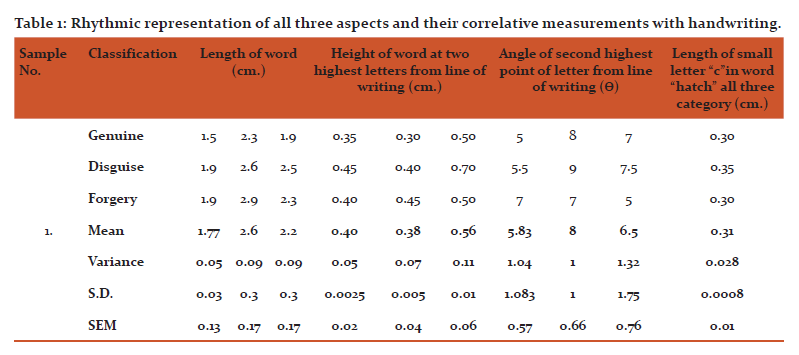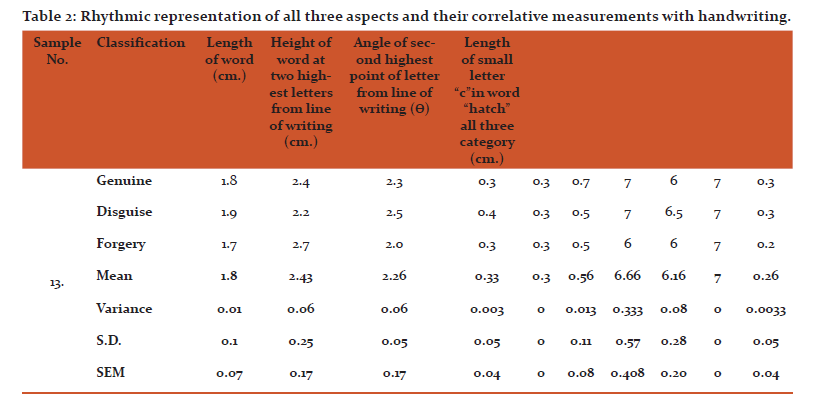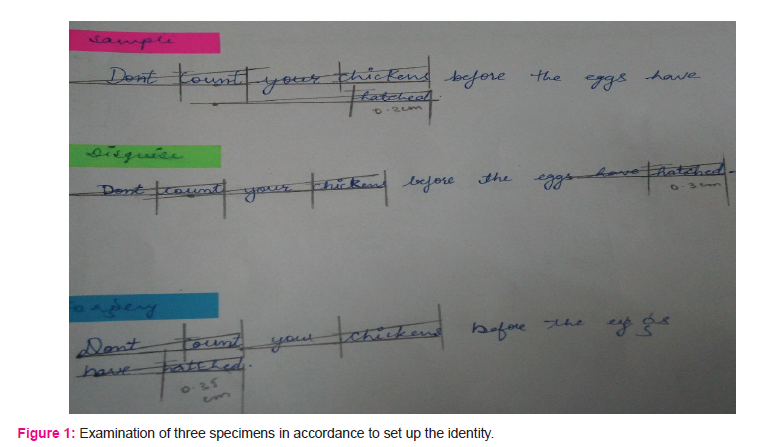IJCRR - 9(9), May, 2017
Pages: 01-05
Date of Publication: 15-May-2017
Print Article
Download XML Download PDF
A correlative Study between the Implementation of Rhythmic System and the Hieroglyphics Substantial
Author: Amit Chauhan, Aditi Chauhan, Jyoti Singh, S. K. Shukla
Category: General Sciences
Abstract:Aim: The aim of the study is to find out the correlation between the hieroglyphics substantial and the rhythmic system of an individual.
Methodology: In this study, we analyzed the three aspects of handwriting such as the legitimate writing, forged and the disguise handwriting samples which were taken to conclude the positive identity of the suspect by the implementation of rhythmic system and adoption of few parameters.
Results: The perfection of similarity is not possible in human work, so some variations were noticed up to a range of \?0.2cm in the measurement while the angle variation was noticed up to a level of 1.5?, while the fourth component was noticed highly significant that is 0.1 cm variation in the handwriting samples.
Conclusion: When any kind of substantial is forged by adopting any kind of practice with perfection though the elements of interpersonal and interpretational variations comes in. This study signifies that adopted parameters gives the concluding identification of an individual and could be endorse by the investigator and could be put on par of all other methods used for questioned documents examination.
Keywords: Handwritten material, Forgery, Metric, Identification, Investigation, etc
Full Text:
INTRODUCTION
At the time of advancement, when technology and scientific methods have taken over the security system and for the safety of society. The identity of individuals is converted into computational language; written materials have been obtained inform of the photocopies or print out from the different systems. Yet, we rely on the documents which are usually kept for records with the signatures of the authority. These documents which consist of any kind of information either visible or invisible that ultimately conveys message to another person[1, 2]. Not in our communal society, even criminals have also not been slow to realize the value of document in one’s life as how they can impact person’s possession and wealth. This trend of artifice often comes in form of the disputed documents, signatures, forgery[3,4]. The origins of the documents which are under dispute are known as questioned document and required a documents examiner to prove their authenticity.
Alteration and edition in security featured documents such as bank cheque’s, willpapers, power of attorney are very common and in the trend since ages. Doing alteration in signatures and writings are becoming easier for forger on the contrary examining them is difficult. Hence handwriting expert is required who has intensive experience and training in his field. Since, the science of handwriting is based on the premise that now two individuals can reproduce the same writing even their own writing and encountered in form of variation[5,6,7]. Variations are natural deviations that occur in a person’s handwriting and known as a complex perceptual motor task. Every individual possess characteristics of their own handwriting into two subdivisions such class characteristics and individual characteristics such as master patterns are unique to individual and helps in identifying the suspects[8].When an individual modifies his/ her own handwriting willfully to conceal his identity is known as disguise handwriting, in which the author tries to keep his identity anonymous and this is mostly used during comparison of specimen[9,10]. The suspect usually change the shape, style of the letter formation, they adopt the someone else’s countenance to write so that no one can find the similarities in first appearance between them. In the process of forgery, the suspect imitate and adapts the writing features of someone else’s with the intent to create a fraudulent document.
In this process, an instinctive process of adding disguise is to change this instinctive process takes a significant and cognizant effort on the part of the author’s to assess a variety of line quality features. In some cases, where the suspects are known encountered and familiar with the exact countenance of victim, the recognition become a tenacious task for examiner to arbitrate their identity[11,12].
As we all know that variations are the intrical part of the handwriting which may not be in the form of countenance, but it could be encountered in form of the metric of suspects written characteristics. The thing that will remain same in one’s handwriting is the measurement of letters and words, which are left unknowingly by the forger. If a person disguises his handwriting he won’t be able to exclude his metric features which are deeply rooted in the handwriting in form of the length, angle from the line of writing and height of the peculiar letters and words will remain same. For, this purpose three types of the handwriting samples were collected which includes, genuine handwriting, forgery, and the disguise handwriting substantial[13,14]. In this study, we focused on four parameters namely, length of specific word, Angle from the line of writing following by the Eudidean geometry’s theorem, height of the two highest similar letters present in word, and the height of anyone small letter present in word to examine the occurrence of the variation. The results of the study were dreadful that even the forger try to avoid their writing style and formation of letters followed by the change in the individual characteristics even left their identity in form of metric of written substantial. Hence, by adopting the rhythmic system in the examination of hieroglyphics substantial can proved an advance step towards conclusive identification. This process can be put on the par of the all questioned documents examination process in court of law[15].
METHODOLOGY
Since diversified types of document examination process has been carried out and some of them still has to come. Questioned document examination is very important aspect for the purpose of identification of suspect in forensic investigation and to establish their conclusive identification with absolute certainty. Hence, sometimes the variations between the interpersonal and interpretational comes in a form of apprehension, therefore to establish the conclusive identification of the author, we implement the metric system to identify the suspect. According to “EUDIDEAN GEOMETRY “there is a single infinity location where all lines meet. All lines intersect at infinity and a whole collection of additional points in one common direction provide projective geometry.
MATERIAL
For this pilot study, we collected 25 samples including males and females from the population of national capital region of India. The sample selection was done randomly without adopting any specific criteria or age group. The subjects were informed prior to sampling process and ethical considerations were taken. Each subject was requested to provide 3 samples in different forms such as genuine handwriting, disguised and forgery in respect of an available printed sentence.
METHODS
For the sampling purpose, all the samples were collected with the help of blue/black/green pen on white A 4 size sheet. All the samples were preserved in a white paper envelop to avoid any kind of moisture effect or ingredient or flow of ink. For the analysis of the sample pencil, scale, protector, hand lens of 5x were used. All the samples are photographed with the help of…
For the statistical purpose SPSS software were used and significance level was examined.
HYPOTHESIS
In the present study, it was considered that the description of an individual can be constituted and a hypothesis was formulated. According to that-
H0signifies that implementation of rhythmic system has concluded the constitute of suspect at 95% level of confidence. While, H1 Implementation of metric system has not a higher significance level at 95% of confidence level.
RESULT
In time, the handwriting/signatures have become highly individualized often in a shape style which distinct it from the original handwriting of the author/suspect. Sometime it depends upon the combined effect, condition, health issues and situation of the author in which he/she writes. The signatures assume greater skills; movement becomes less primitive and elementary and the elements approximate to a greater or lesser degree of the writing that individual studies with more advanced authors inherits. The conditions under which these standards are prepared make it imperative that certain precautions be observed so that their comparison value is not impaired. In many instances the person who prepared the writing will freely admit the fact, especially when it in no way seems to incriminate him or to prejudice his case. Stipulations about the genuineness of certain standards can often be obtained if asked for,
To begin identification, the known writing is examined for naturalness in execution and for repeated consistent features that determine the established habit of the writer [16]. Some examiners begin an examination by formulating the hypothesis that the questioned writing is not written by the writer of the exemplar writing and attempt to prove the hypothesis. If the hypothesis cannot be proven based on the evidence, then the examiner can begin again using the hypothesis that the same person wrote both the questioned and exemplar writings[17]. In this study, the four parameters namely length of the word from starting pen pause to the end pen pause, height of the word at the highest letters from the line of the writing, angle of the highest point (letter) from the line of the writing, and the length of the letter present in between the word, were presumed for the identification establishment (figure-1).
In genuine writing of the author, the measurement of the all three words (as described in table no. 1) for “count” 1.5cm., For chicken 2.3cm, and for hatched 1.9 cm. While in disguise handwriting, it was; for count 1.9 cm., for chicken 2.6cm. and for hatched 2.5cm. For the same author, the measurements in forgery of count was 1.9cm, for word chicken 2.9 cm., and for hatched it was 2.3 cm. In which the mean of word count in all three parameters; values lie in between 1.77 cm, S.D. value as 0.03 and SEM was 0.13 which is an indication of natural variation.
For second component of first parameter, the values lie in between 2.6 cm, S.D. value as 0.3 and SEM was 0.17. For third component of first parameter, the values lie in between 2.2 cm, S.D. value as 0.3 and SEM was 0.17. For the second parameter, height of word at two highest letters (t) in word “count” in all three aspects from line of writing in writing was 0.35 cm, 0.30 and 0.50 cm, while for word “chicken” in handwriting, it was 0.45cm, 0.40cm and 0.70cm., and for third word “hatched” it was 0.40cm, 0.45cm & 0.50cm. In which the mean values lie in between 5.83 cm, S.D. value as 1.08 and SEM was 0.57 which is an indication of natural variation. Similar like of it, in second word observed values lie in between 8 cm, S.D. value as 1 and SEM was 0.76 and in third values lie in between 6.5 cm, S.D. value as 1.75 and SEM was 0.76.
The third parameter, Angle of highest point of letter in the word “count” from the line of writing, in all three handwriting was noticed up to 5?, 5.5?, and 7 ?. And the mean was 5.83, S.D was 1.08 while the standard error mean (0.57) was noticed. While for second letter “chicken” the measurement of hand writing angles from line of writing were 8?, 9 ?, 7?, whose mean value was 8cm, S.D. 1cm and SEM was 0.76cm were observed. In the last third word “Count” the measurements of angles in all three aspects from the line of writing were obtained as7 ?, 7.5?, 5 ?. In which the mean values lie in between 6.5 cm, S.D. value as 1.75 and SEM was 0.76 which is an indication of natural variation. At the duration of sample examination, which was considered the fourth parameter in the handwritten substantial; the height of the middle letters “c” present in the all three words was also noticed whose dimensions were 0.30 cm, 0.35 cm and 0.30 cm. In which the mean values lie in between 0.31 cm, S.D. value as 0.0008 and SEM was 0.01 which is an indication of natural variation. Similar another measurement is mentioned are shown in table 2 below-



In this study, it was noticed that there is a minor change in the measurement of the different handwritten material of same individual. If a person knowingly make changes in his/her writing, in that case various letters formations are noticed because the person remain alert. While imposed the same measurements of their own handwriting which was identical for individuality.
DISCUSSION
As per the statement mentioned in methodology, the measurements were taken from the genuine handwriting, disguise and forgery and three words (count, chicken, hatched) were selected in each type of handwritten samples. Since it is known that human is not a machine who will work similar like machine so, variation was noticed up to a range of ±0.2cm in the measurement while the angle variation was noticed up to a level of 1.5?, while the fourth component was noticed highly significant that is 0.1 cm variation in the handwriting samples. Some of the variations may be the presence of human error during examination or instruments variation. These parameters can be adopted for the examination of handwritten materials when the identity of suspect become a necessity and other examination fail to provide the clue. Such examination of substantial will prove their importance in getting to nab the suspect and can be put on the par of other exists techniques of examination in court of law.
CONCLUSION
In this present study, an attempt has been made for the identification of the suspect with the implementation of rhythmic system from the questioned handwriting substantial. As we have contemplated that an imposture may be transpired in diverse ways. For one of the successful to the expansion that it prevents recognition under concealed by the expert study, it must duplicate all the attributes of the authentic signatures to a degree that disparities are few and can be attributed to chance or to the normal range of variation in genuine substantial. Not only the form of letters but the qualities of writing movement must be accurately reproduced so that the problem involves imitating simultaneously a few characteristics rather than each one singly. There are curbing factors that sometimes preclude absolute identification and eliminations of forger.
The outcomes of this study are very satisfactory and encouraging that will be helpful in the examination of different type of handwritten substantial and facilitate with a new approach towards the examination. The inquisitor should be aware about the limitation of some type of evidences and shouldn’t be inveigled by the circumstances of the case and render any subjective conclusion. There is numerous mechanism of document examination which allows the litigators to testify in court of law. Questioned substantial exploration is a challenging and distinct area of research that mainly deals with new investigative techniques and with a new expertise in the area of examination. In this area of interest, the researchers become comprised further to enlarge the area which may require circumspect continued education keeping abreast of new evolution and technology. These types of advancement can carry forward the examination of document for establishing the identity and can put on the par above of all evidences in court of law.
ACKNOWLEDGEMENT
The Authors acknowledge the immense help received from the Honorable Founder President of Amity University and to the Chancellor who provide all the facilities in the university for this work. The authors are also grateful to editors/publishers of all those articles, journals and books from where the literature for this article has been reviewed and discussed.
Conflict of Interest; Nil
Source of Funding; Nil
References:
- Kam M, Gummadidala K, Fielding G, Conn R. Signature authentication by forensic document examiners. J Forensic Sci 2001 vol. 46 Pp; 884–888.
- Huber RA, Headrick AM. Handwriting Identification: Facts and Fundamentals. Boca Raton, FL, CRC Press, 1999, p. 29.
- Homewood SL, Oleksow DL, Leaver WL. Questioned Document Evidence. California Lawyers 1998: VIII-4.
- Hilton O. Scientific Examination of Documents. Chicago: Callaghan & Company, 1956.
- Srihari SN, Cha S-H, Arora H, Lee S. Individuality of handwriting. J Forensic Sci 2002, Vol. 47, Pp ;856–872.
- Mehta MK. Identification of handwriting and cross examination of experts. Fourth edition, 1970.
- Ron N. Morris. Forensic Handwriting Identification: Fundamental Concepts and Principles”, Academic Press, Tokyo 2000
- Ordway. Hilton. Scientific Examination of Questioned Documents. Elsevier Science Publishers B.V. 1982
- Billy Prior Bates. Identification System Of Questioned Documents (ISQD). Charles C Thomas Publishers 1970.
- Willson. R. Harrison (1958), “Suspect Documents- Their Scientific Examination”, Nelson- Hall Inc. Canal St., Chicago, IL.
- Russell. A. Gregory. Identification of Disputed Documents, Fingerprints and Ballistics. Fifth Edition, Eastern Book Company. 2005
- Alford, E.F. Disguised Handwriting. A Statistical Survey of How Handwriting is Most Frequently Disguised. Journal of Forensic Sciences, 15 (4) 1970, October, pp.476-488
- Alford, E.F. and Dick, R.M. Intentional Disguise in Court-ordered Handwriting Specimens. Journal of Police Science and Administration, Vol. 6 (4) 1978, pp.419-423.
- Authentication of Disputed Writings by Comparison: The Expert Witness University of Pennsylvania Law Review, Vol. 104 (5) 1956, March, pp.664-678
- Baxter, P.G. Classification and Measurement in Forensic Handwriting Comparisons. Medicine Science & The Law, 13 (1973), pp.166-184.
- Bethlehem, J. Applied Survey Methods: A Statistical Perspective. New Jersey: John Wiley & Sons, Inc. 2009.
- Conway, J.V.P. The Identification of Handprinting. The Journal of Criminal Law, Criminology, and Police Science, Vol. 45 (5) 1955, January - February, Pp.605-612.
|






 This work is licensed under a Creative Commons Attribution-NonCommercial 4.0 International License
This work is licensed under a Creative Commons Attribution-NonCommercial 4.0 International License